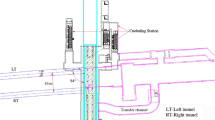Abstract
Complex tunnel geometries are very common during the design of urban tunnelling and especially metro lines. Relevant complexities were common during the construction of Athens Metro in Greece, where the need of giving access to trumpet areas, multi-storey underground constructions and transition zones produces special design requirements. Characteristic case histories are the trumpet area as well as the access gallery and chamber to Egaleo Station in the same extension, which are presented in the paper. In both cases, the real challenge was to give solution to underground complex constructions within short lengths of different tunnel profiles. In the first case, a triple-track tunnel splits to a single and a double-track one, while on the second one, a three-storey access gallery was constructed at the north side of Egaleo Station in order to give access for the construction of the station. According to the geology in the area, the Athenian schist was expected, completely weathered on the top and from low to medium strength deeper. The main criteria of the design was to result to a construction methodology such as to assure stability, low surface settlements and convergences, safety, quality and construction advance, within a realistic solution to the constructor. In both cases, the conventional tunnelling method was applied with success, not only regarding the final surface settlements which proved to be small, but also the speed and the convenience in applying on site the designed procedure.

















Similar content being viewed by others
References
Anagnostopoulos A et al (eds) (2011) Proceedings of the 15th European conference on soil mechanics and geotechnical engineering. IOS Press, Amsterdam
Attewell PB, Yeates J (1984) Tunneling in soil. Ground movements and their effects on structures. In: Attewell PB, Taylor RK (eds) Surrey University Press
Coetzee M et al (1998) FLAC basics. Itasca Consulting Group, Inc. Construction, Minneapolis
Davis et al (1980) The stability of shallow tunnels and underground openings in cohesive material. Geotechnique 30(4):397–416
Hoek E (1999) A discussion on acceptability criteria for temporary support and final linings of large span transportation tunnels in poor rock. In: Proceedings of Egnatia Odos S.A, Conference, Greece
Hoek E, Brown ET (1980) Underground excavations in rock. Instn Min. Metall, London
Kavvadas M (1999) Experiences from the construction of the Athens Metro Project. In: Proceedings of the 12th European conference of soil mechanics and geotechnical engineering, Amsterdam, vol 3, pp 1665–1676
Kolymbas D (2003) Advances in geotechnical engineering and tunnelling. Rational Tunnelling, Summerschool, Innsbruck
Mair R, Taylor RN (1997) Bored tunneling in the urban environment. In: Theme Lecture, Plenary Session 4, Proceedings of 14th international conference SMFE, Hamburg, Germany, 1997, vol. 4
Oteo CS, Sagaseta C (1982) Prediction of settlements due to underground openings. In: Dungar R, Pande GN, Studer JA (eds) Numerical models in geomechanics. Zurich, Switzerland
Panet M (1979) Time-dependent deformations in underground works. In: Proceedings of the 4th ISRM Congress (Montreux), vol 3, pp 279–289
Panet M (1997) Understanding deformations in tunnels. In: Hudson JA (ed) Comprehensive rock engineering, vol 1. Pergamon, Oxford, pp 663–690
Sakurai S (1983) Displacement measurements associated with the design of underground openings. In: Proceedings of international symposium field measurements in geomechanics, Zurich vol 2, pp 1163–1178
Wang Y (1996) Ground response of a circular tunnel in poorly consolidated rock. ASCE J Geotech Eng 26(2):137–163
Acknowledgments
“Attiko Metro” S.A. was the supervising authority responsible for the design and construction of the Athens Metro Project. AKTOR S.A.-IMPREGILO S.P.A. consortium was the contractor for the construction of the Western Extension of Line 3 from Assomaton Shaft to Egaleo Station. The design was performed by “OTM S.A.” Engineering Consulting Company.
Author information
Authors and Affiliations
Corresponding author
Additional information
*Previously published in Anagnostopoulos et al. (2011). Reprinted—Published in revised form with kind permission of IOS Press.
Rights and permissions
About this article
Cite this article
Schina, S., Charalampidou, A. Athens Metro Line 3: Complex Tunnel Geometries. Geotech Geol Eng 32, 1451–1466 (2014). https://doi.org/10.1007/s10706-013-9706-7
Received:
Accepted:
Published:
Issue Date:
DOI: https://doi.org/10.1007/s10706-013-9706-7




